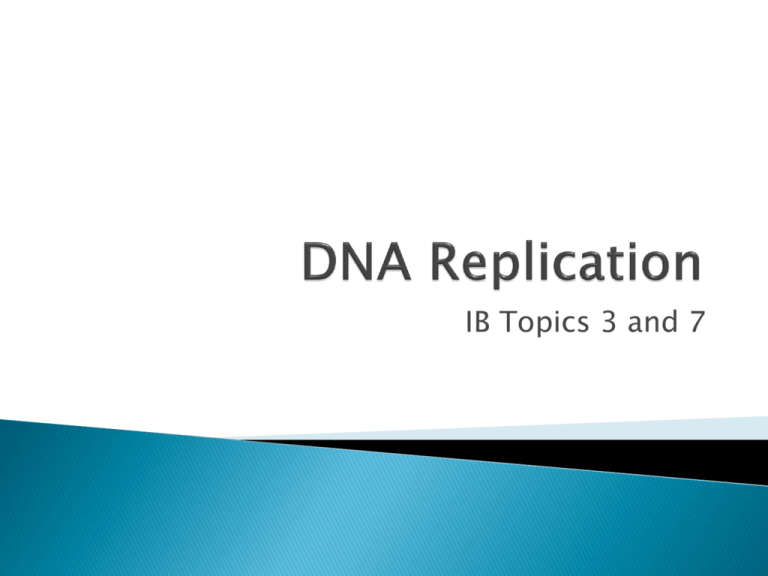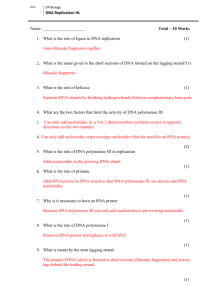DNA Replication
advertisement

IB Topics 3 and 7 DNA replication is a means to produce new molecules that have the same base sequence Occurs during interphase of the cell cylce DNA replication is semi-conservative ◦ The parent DNA strand separates into two ◦ Each strand serves as a template for new complementary strands ◦ The new double helix is half original 1. Bacteria were grown in a medium containing nitrogen 15 (N15) for several generation 2. If the medium contains no other nitrogen source, the E. coli will use N15 and incorporate it into their DNA 3. Eventually, they will only have N15 4. Once the E. coli had only N15 they were put into a growing medium contain only N14 5. N15 is heavier than N14 making new incorporation of nitrogen easy to distinguish 6. The differences were measured according to the densities of the new strands -Explain what is happening in this diagram. -Which color is N14? N15? -Which model of DNA replication is illustrated? -Why aren’t there double helices with two red strands in the 2nd generation? Occurs in a 5’→3’ direction ◦ The 5’ end of the ‘new’ nucleotide attached to the 3’ end of the nucleotide before it DNA is unwound and unzipped by the enzyme helicase DNA polymerase III creates links between the nucleotides ◦ It creates a strand that is complementary to the original strand) Replication takes place at several places on one double helix at the same time Once the double helix is unwound and unzipped the two parent strands become the leading and lagging strands This happens because the strands are antiparallel 3’ 5’ 5’ 3’ The lagging strand runs from 3’ to 5’ 1. Before DNA replication begins there must be an RNA primer 2. The RNA primer is made by adding complimentary RNA nucleotides to the lagging DNA strand by hydrogen bonding of the bases ◦ RNA has uracil instead of thymine 3. RNA primase (an enzyme) then bonds the RNA nucleotides together RNA primer RNA primase 3’ 5’ 4. After RNA primer is in place DNA nucleotides are added by DNA polymerase III 5. Eventually, the segment of DNA will run into another RNA primer 6. The DNA segments are called Okazaki fragments Okazaki fragment RNA primer DNA polymerase III 3’ 5’ 7. Once Okazaki fragments are formed DNA polymerase I replaces the RNA primer with DNA nucleotides 8. DNA ligase links the fragments together 5’ 3’ New strand Parent strand 3’ 5’ In the lagging strand DNA replication is discontinuous DNA is replicated in segments that become joined together Replication is continuous There are no fragments Helicase unwinds and unzips the double helix DNA polymerase III adds nucleotides in the direction of 5’→3’ ◦ DNA polymerase only works in the direction of 5’→3’ Lagging strand ◦ Formed in short segment of 100-200 nucleotides (these are the Okazaki fragments) ◦ Grows in direction of 5’→3’ because DNA polymerase III only works in the 5’→3’ ◦ 1. Helicase unwinds and unzips the parent DNA ◦ 2.RNA primer is formed by RNA nucleotides that are joined together by RNA primase ◦ 3. DNA polymerase III bonds DNA nucleotides to the RNA primer ◦ 4. DNA polymerase I replaces the RNA primer with DNA nucleotides ◦ 5. DNA ligase joins the Okazaki fragments together Leading strand ◦ 1. Helicase unwinds and unzips ◦ 2. DNA polymerase III adds complimentary DNA nucleotides The leading and lagging strand are determined by the 5’ and 3’ end of the strand. 5’ 3’ Which template will be the leading strand? 3’ 5’ 5’ 3’ 3’ 5’ McGraw Hill Explain DNA replication. Use p. 284-289 to help you. Include drawings and annotations to aid your explanation.






